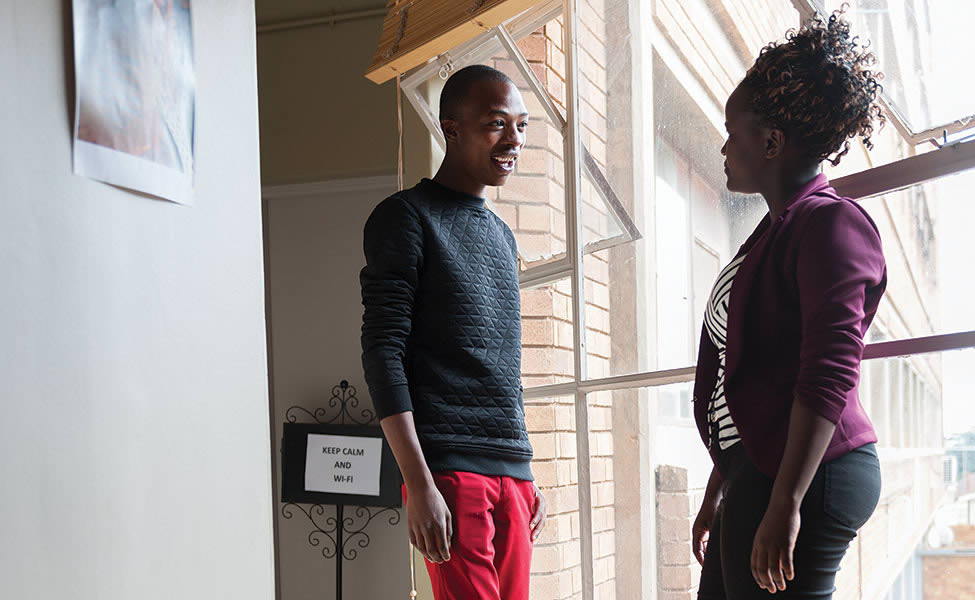Young Lives
The key to maintaining South Africa's success in HIV/AIDs? Adolescents.
The Chris Hani Baragwanath Hospital’s tall buildings dot the highway like a brown brick archipelago in a sea of single-story, tile- and tin-roofed homes. It’s morning in Soweto—the southwestern township of Johannesburg—and the sprawl is waking up: Taxis whiz by, vendors hawk sweets and construction starts up.
In a conference room atop a converted nurse’s residence, Heena Brahmbhatt, PhD ’02, MPH ’96, and Avy Violari, MD, are talking about teenagers. As senior collaborators at the Perinatal HIV Research Unit, headquartered in the hospital, they’ve spent years investigating HIV prevention and treatment for mothers and newborns, but increasingly they’re focusing on adolescents, an understudied group.
“You have to understand that adolescents are really not interested in ARVs,” Violari says, referring to the lifesaving antiretroviral drugs used to suppress HIV infection and reduce transmission. “When I consult with them, the first thing is, ‘How are you...’ and then they‘ll say something like, ‘Well, I have a pimple right here, you see?’” Violari mimes the application of makeup in front of an imaginary mirror. “And you know, I cannot even see the pimple. I’m trying to go back to the topic of ARVs, but then they take me back to acne, which is nonexistent.
“It‘s just because they’re adolescents,” she says.
In the coming years, South Africa will be home to a bulging population of 500,000 HIV-positive adolescents and more than two million AIDS orphans. Most of these HIV-infected young people were born with the virus. In Soweto, which has an estimated population of 2.5 million to 4 million people, hospitals deliver around 30,000 babies each year. One-third are born to HIV-infected mothers. The worry is that as more HIV-positive adolescents mature and become sexually active, they could undo many of the gains made by the nation’s prevention strategies. This population could also act as a reservoir for common HIV-related co-infections like tuberculosis, so their potential impact on the nation’s health is tremendous.
Successfully treating South Africa’s young people will be an integral part of meeting Fast Track goals established by the Joint United Nations Programme on HIV/AIDS (UNAIDS) to end the HIV/AIDS epidemic by 2030. For researchers, however, the questions are daunting: How can they develop treatment tailored to adolescents? How can they keep those adolescents engaged in the treatments they’ll need for the rest of their lives?

FILLING IN THE KNOWLEDGE GAP
The impending reality of 500,000 HIV- infected adolescents underscores the tragedy of the HIV/AIDS epidemic, as well as the triumph of South Africa’s response. While this is an unprecedented number of infected individuals, these are also individuals that, without access to ARVs, often wouldn’t have survived past childhood.
"It’s a group whose needs haven’t been adequately addressed,” Violari explains. “Because HIV-infected kids were dying before, they didn’t really live to adolescence.”
Drug adherence is particularly challenging for young people. They forget to take their daily pills, don’t take them because they feel fine or skip doses when friends are around. Stigma remains prevalent despite the virus’s ubiquity. Moreover, many HIV-positive adolescents are unaware of their status—it’s common for parents to tell them that they have diabetes or asthma.
Brahmbhatt, an associate professor in Population, Family and Reproductive Health, is familiar with these issues. She began her career in Uganda in the mid-’90s, working with Bloomberg School Professor Ronald Gray, MD, MSc, studying mother-to-child HIV transmission rates. As those rates improved in the following years, Brahmbhatt’s attention turned to children.
“Since the introduction of ARVs, we’ve done a really good job at significantly reducing the risk of HIV transmission in children,” Brahmbhatt says. “And the real issues now have become what’s happened to those children”—those born HIV-positive and now on treatment, and also those born to HIV-positive mothers but who escaped infection—“and what happens to them in the long term as they’re transitioning to adolescence?”
To help fill these knowledge gaps, like how to encourage adolescents to get tested, avoid risk behaviors or adhere to treatment, Brahmbhatt develops studies with PHRU and the Wits Reproductive Health and HIV Institute in Johannesburg.
Some lessons she learned elsewhere in Africa have been valuable in South Africa. A study Brahmbhatt led in Botswana, in which HIV screening was offered to patrons at shabeens, or taverns, found enormous demand: Seventy-five percent of eligible patrons enrolled in the study, which included such screening. The lesson? If it’s made convenient, people will get tested.
Similarly, Brahmbhatt has evidence that cash incentives can dissuade at-risk adolescent girls from engaging in transactional sex with older men—a leading cause of HIV infection. In much of sub-Saharan Africa, girls typically become sexually active five to eight years earlier than their male peers, often in order to gain supplemental income for their families, or for personal items like school uniforms. Brahmbhatt looked at the impact cash incentives had on behaviors like school attendance and health clinic visitation, and she’s encouraged by the results: She and her team found that clinic visits increased by a third.
Still, adolescents require a holistic approach. Part of the reason is neurobiological. There’s a growing consensus that the portion of the brain responsible for risk-benefit analysis doesn’t mature until one’s early 20s. “Adolescents are very aware of the risks,” she says. “They just tend to overestimate the rewards.”
That’s why basic drug adherence is difficult for teenagers. They know its importance—it’s been drummed into their heads by pediatricians since they were young—but they just tend to underestimate their own long-term risk of getting sick (by not taking their pills) because they focus too much on short-term worries (their friends may see them taking pills). “Their way of thinking of rewards is inflated and unrealistic,” she says.
Adults have created failed behavioral interventions (often based on increasing knowledge) because that’s how they think, but it’s not how adolescents think.
Soweto’s urban poverty and lack of opportunity compound these challenges. The Well-Being of Adolescents in Vulnerable Environments Study, published by Brahmbhatt and colleagues in 2014, examines how environment affects health. They found that young people around Johannesburg were more than twice as likely as peers in other cities, like Delhi, to have sexual experience. (The only site with similar rates was Baltimore.) Additionally, youth in Johannesburg reported more mental health problems, substance abuse, pregnancy and sexual violence.
There’s a sense that if adolescents can be cared for in this setting, with these challenges, then they can be treated anywhere. Yet effective treatment will remain elusive without involving adolescents directly.
“I think the solutions will come from them,” Violari says. “From engaging with them, not from us.”
To emphasize her message, she points to the clinic downstairs.

WHERE YOUNG ONES SHINE
Laughter bounces down an orange hallway in the Kganya Motsha Adolescent Center, which offers health services to young people in Soweto, and from which the PHRU recruits participants for its studies. Janan Dietrich, PhD, MA, whose background is in psychology, manages the clinic.
The laughs come from Leonard and Nomathemba, two 20-something youth ambassadors relaxing in the lounge. A steady stream of adolescents visits each day to receive counseling in adjacent offices, or just to watch YouTube. Everything in this clinic is informed by young people, including its name, which means “Shine, Young Ones” in Sesotho.
“You only learn when you incorporate the adolescents,” says Stefani Hornschuh, a program manager overseeing the AYAZAZI longitudinal study, which draws its name—meaning “Knowing Yourselves” in Zulu—from adolescent input as well. Hornschuh relies on Leonard and Nomathemba to recruit AYAZAZI participants and to shape studies—asking them to review survey questions, for example.
Despite the high numbers of HIV-infected adolescents, clinics tailored to their needs are practically nonexistent in South Africa, so Kganya Motsha is special. More commonly, adolescents stick to pediatric care well past puberty and are later referred to adult facilities. That handoff creates abandonment issues, as the nurse practitioners or pediatric clinicians—such as Violari— often lose contact with patients they’ve known since birth.
“These adolescents could have lost their parents, and then they get looked after by an aunt,” says Violari. “She might also have HIV and die. Then they get looked after by a grandparent; some of them get foster care. Sometimes we are the only people who provide stability in their lives.”
Violari dreams of establishing a multidisciplinary team of psychiatrists, neuropsychologists, social workers and others to address all of their adolescent patients’ needs—even beyond the medical. Likewise, she envisions a future in which HIV is classified with other chronic illnesses and treated under the same roof.
She notes that HIV-infected children and adolescents are at greater risk for neuropsychological impairments, such as early dementia—another focus of her and Brahmbhatt’s study. And there are implications that HIV can have an impact on cancers or other chronic illnesses like lymphoma, hypertension and cardiovascular disease. Down the line, as HIV-positive adolescents live longer and with more associated chronic illnesses in this setting—rife with hypertension and obesity—it will make sense to have all of these patients in one setting where expertise can be shared.

HIGH COSTS, LIMITED RESOURCES
Optimists believe interventions to prevent mother-to-child transmission and to expand male circumcision will mean fewer HIV-positive adolescents in the future. Longer-acting forms of ARVs may also one day allow recipients to skip doses and would be particularly attractive to adolescents.
Still, cost and limited resources present challenges. Power outages are common, interfering with treatment and research, says PHRU executive director Neil Martinson, MPH ’01.
Perhaps most worrisome: Resistance to antiretrovirals can make the cost of treatment surge. First-line ARVs, which contain three antiretroviral drugs, are subsidized by the South African government and provided for free to HIV-infected individuals. Unfortunately, children taking ARVs from birth can develop resistance by the time they reach young adulthood. By then, they require second-line treatment, which costs about 10,000 rand per month ($744 USD)—far beyond the reach of the 60 percent of households in Soweto that earn less than $3,000 annually.
GROWING UP UNCERTAIN
From outside, the sound of roadwork thumps windowpanes. Soweto is changing. Each year, new settlers arrive, drawn from rural regions. This movement, on a macro level, mirrors a global trend toward urbanization. Migrants carry hope of better, more secure lives. Upon arrival, they build shelters beside more established homes. They use sheet metal, tin and wood at first, and later fortify them with cinder blocks, brick and cement. Development ripples outward: paved roads, new shopping malls and restaurants. Near the PHRU offices, sunlight bounces off metal tables belonging to a newly opened café—its existence unimaginable a few decades ago.
Signs of transition abound. Soweto changes, and so do its inhabitants. Access to technology, education, health care and employment is rising. Adolescents are growing up in a setting that itself is maturing. They forge ahead, carving out their own lives. Nearby, researchers grapple with how to keep those young people healthy, how to prevent newborns from growing up sick, how to ensure that Soweto will grow healthier with each generation.
Progress looks undeniable. But the future is far from certain.
